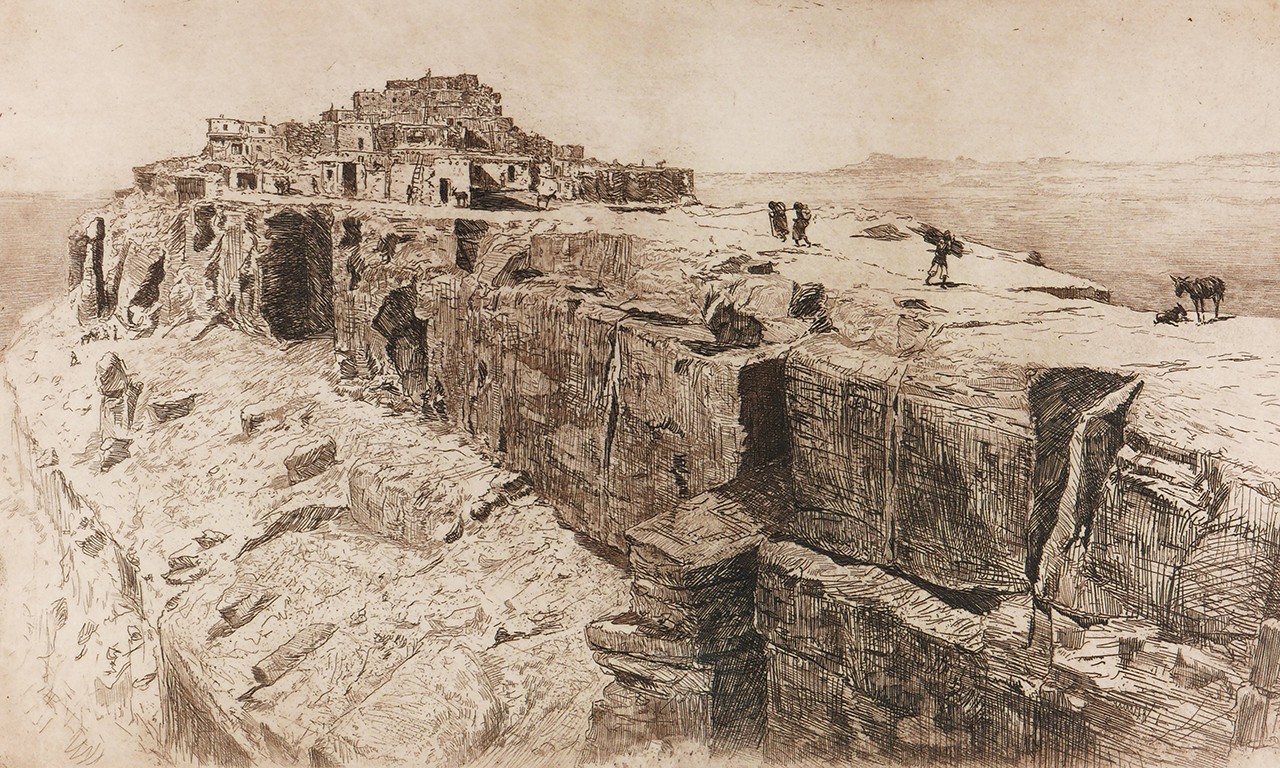 |
Walpi, 1919
Edward Borein (American, 1873 - 1945); Walpi, Navajo County, Arizona
Drypoint and etching; 8 × 13 5/8 in.
2021.2.1
Jim and Jeanne Pieper Collection |
Ash Hill Terrace
Soaring high above the canyon floor of the Hopi Reservation in Arizona, Walpi has been the site of a mesa village since the 10th century. Like many Hopi villages, its perch offered a vantage to easily track movement through they valley and its inaccessible location made it easy to defend in the case of threats from neighboring groups. When the Spanish converted their way through Mexico and parts north, and the British and later Americans committed atrocities against the Indigenous Peoples of the continent as they manifested westward, Hopi communities were at least relatively less affected by Western influence. At Walpi the Hopi practiced arts and agriculture as their people had for more than two millennia until the mid to late 19th century when roads and railways finally made even the most remote swaths of Arizona accessible to Europeans. The tessellated, cubic geometries of pueblos struck romantic chords for starry-eyed tourists who—cameras and brushes in hand—flocked to the stark and endless desert to explore them and meet their inhabitants. This post looks at four depictions of Walpi made in the late 19th to early 20th century in the context of their artists and the traditional customs and features of the village.
 |
Photographs of Edward Borein, George Benjamin "Ben" Wittick, Evylena Nunn Miller, and Isaac Jenkinson Frazee
Public domain and Bowers Museum Collections |
Artist Formerly Known for Prints
Walpi is the title and subject of the above 1919 print by the famous cowboy-turned-artist Edward Borein. He was a rare case for early painters of the west in that he was born in California in 1872. In part because both his father and grandfather were famous riders and in part because he himself had started out that way, he was drawn to dramatic images of cowboys and the American West in its final years of being a frontier. Many of his works, like this etching, also feature Indigenous Peoples and their settlements. His print illustrates the narrow path to Walpi, and the means most employed for delivering goods: donkeys. Walpi was evidently important to Borein, as near the end of his life he built a home in Santa Barbara styled after a traditional Hopi pueblo.
 |
Flute Dance, 1898
Possibly George Benjamin "Ben" Wittick; Walpi, Navajo County, Arizona
Photographic print; 6 x 8 in.
19504
Gift of Mr. and Mrs. Harrie H. Teaboldt |
Snake Washing
Inscribed, “Flute Dance, Walpi, Arizona, 1898” on its reverse, this photograph was taken at the Hopi Snake Dance, a rainmaking ritual held at Walpi every other year. The ceremony took place over the course of nine to sixteen days, much of it in the privacy of kivas. During public portions men circumambulated a natural pillar at Walpi while holding snakes in their mouths. Despite the handwritten note, the photograph was likely not taken in 1898 as descriptions of the dance indicate that it was preformed at Walpi only on odd years. Evylena Nunn Miller, the painter of the below artwork, further confirmed in a note that in the 1920s Walpi and the Hopi village of Hotevilla-Bacavi alternated in holding the Snake Dance. Indeed, information about this image is lacking in many regards. Its photographer is not known, but an almost identical picture of the 1887 dance may indicate that it was taken by Ben Wittick who was most famous for his iconic tintype of Billy the Kid. It is worth noting that Walpi has been a magnet for many celebrities and photographers, both Edward Curtis and Ansel Adams shot famous photographs there, and Theodore Roosevelt was a guest of honor at the 1913 Snake Dance.
 |
End of Walpi, c. 1925
Evylena Nunn Miller (American, 1888-1966); Walpi, Navajo County, Arizona
Oil on canvas; 30 x 24 in.
19751
Gift of Evylena Nunn Miller |
Logging in Paint
The Bowers Blog has previously explored the paintings of Evylena Nunn Miller in great detail. Throughout all of her world travels, that the American Southwest was the locale she returned to most often is well evidenced in the Bowers permanent collection. She has paintings of most of the Hopi pueblos, many of which have associated stories from the day she spent painting en plein air. The ladder she paints shooting out of the roof of a pueblo demonstrates how, along with stairways, the Hopi traversed their multi-story villages.
 |
The Blanket Weaver, late 19th to mid 20th Century
Isaac Jenkinson Frazee (American, 1858-1942); Walpi, Navajo County, Arizona
Oil on canvas; 20 x 24 in.
20411
Gift of Elizabeth Frazee Worsley and Christian A. Worsley |
Turn of Frazee
Isaac Jenkins Frazee is a name that comes up often when researching the history of art in Orange County. He was a celebrated, cerebral painter, historian of American Indians, well-published poet, theatre aficionado, and community organizer—he laid the cornerstone of an artistic legacy in Southern California that remains to this day. Like many California painters, he took frequent trips eastward to paint the desert and Walpi is the subject of at least one of those paintings. The Blanket Weaver depicts a lone individual practicing the traditional Hopi method of weaving. Frazee’s vibrant palette and blurred textures make the First Mesa and vast canyon floor beyond appear almost as if they were the all-too-familiar Californian scene of a bluff overlooking the sea.
Text and images may be under copyright. Please contact Collection Department for permission to use. References are available on request. Information subject to change upon further research.






Comments